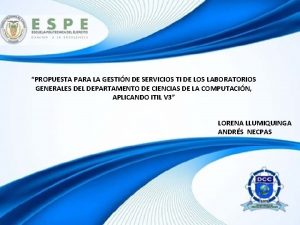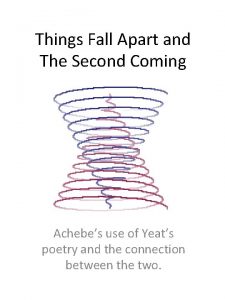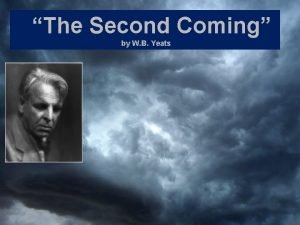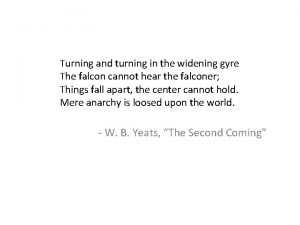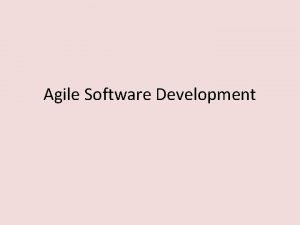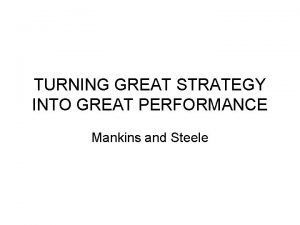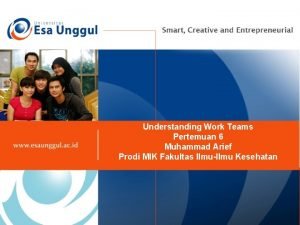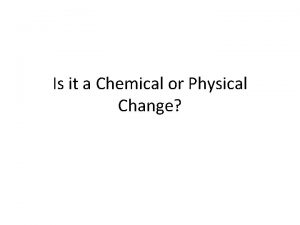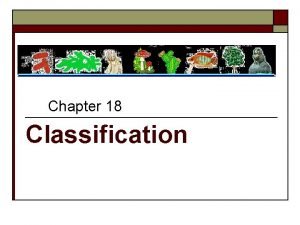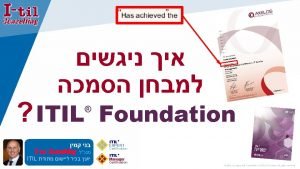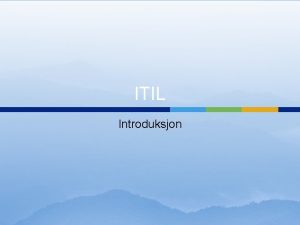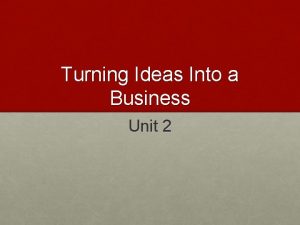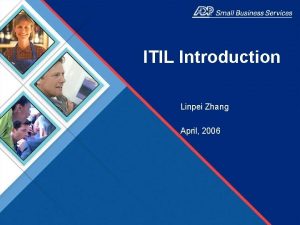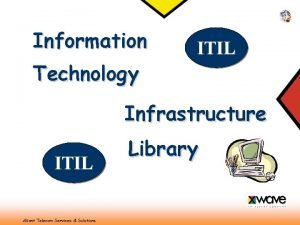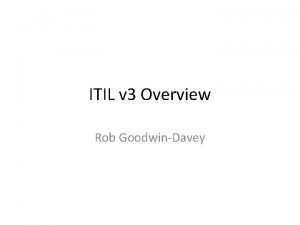ITIL Manifesto Turning Grouped Ideas into Principles Deadline












- Slides: 12

ITIL Manifesto Turning Grouped Ideas into Principles Deadline for submissions: 31 May 2015

Guidance This resource pack has been produced to help individuals or groups distill the gathered ITIL Manifesto ideas into principles that will become the body of the manifesto. For each of the 6 value proposition idea groups: 1. Review the grouped ideas (numbers in brackets denote #votes from the original Tricider. com poll. 2. For the ideas you think are relevant, write 1 or 2 statements that encapsulate the essence of the ideas as they relate to the topic (one of the 6 ITIL value propositions). 3. Identify which ideas you think have been covered. 4. Once you’re happy with the result, send this to rob@changeandrelease. com with a brief note about who you are (individual or group). “_________________” Many ideas distil to one or two principles

Need help? If this doesn’t make sense, if you need help understanding what to do or you have any questions, please email rob@changeandrelease. com – I’ll happily set up a skype or google hangout one evening/weekend (UK time) to walk you through it. I’m also available to answer any questions you have via email at pretty much any time. ?

Example This is an example of how the ‘Support Business Outcomes’ ideas were distilled down into two sentences.

Mission / Vision As of early May 2015, the formal vision/mission of the ITIL manifesto hasn’t been agreed, however work by Simone Jo Moore, Daniel Breston and Peter Brooks resolved to the following: “The ITIL Manifesto exists to encapsulate the practical application of the ITIL framework content and the essence of the guidance it contains. Driven by the ITSM community, the Manifesto evolved using the same principles within the framework and with the industry’s exploration and collaboration in Service Management. ” You can also give us your Feedback on the Vision/Mission:

Group 1: Support Business Outcomes I-92 Tangible outcomes over services (0) I-01 Prioritise outcomes that affect customers over internal IT metrics (18) I-96 The focus is not to be ITIL compliant (as many do), but improve your business using ITIL best practices. Can you prove this? (0) I-102 It's not about developing processes, it's about developing a mentality of enabling customer outcomes in the form of service provided by IT (0) I-87 My browser counts 42 occurrences of the word "process", 3 occurrences of the word "community" and 1 occurrence of the word "collaboration" (0) I-86 The crucial chain: requirements - design - outcomes -> value is an essential of ITIL that's often ignored, neutering any attempt to get genuine value. (0) I-04 Customer satisfaction over SLA compliance (11) I-12 Creating value for customers is more important than meeting SLA targets (6) I-68 IT services exist to support business processes (0) I-71 As a matter of fact, ITIL is not about IT; it's all about the business (0) I-02 Processes are ways of dealing with repeated tasks in a structured way, freeing up time for more complex activities. They aren't an end in themselves (14) I-16 Many activities cut across multiple processes - it's the value creating work that matters, not the process (5) I-59 The first question is always “what does your customer want? ”� (0) I-74 Agree with the statement "ITIL is not about IT; it's all about the business". The business is experiencing a joyous rethink of what to expect from IT suppliers as a result of cloud, that rethink is having a big impact. I don't see anything here about a cloud-centric definition of managing services. And it's not about the technolog, it's about changing expectations which a whole new platform is meeting collaboratively. (0) I-83 The focus of ITSM is on delivering successful Business Outcomes and Customer Experience (0) I-23 To be viewed as a strategic asset, customers and service providers need to view each other as partners (sharing in successes) (3) I-31 Control on results over Control on activities (2) I-49 Practical experience applying ITIL over Certifications (1) I-82 ITSM enables successful service delivery. (0) I-21 Business facing target and agreements should be technology agnostic (4) I-26 Understand & measure outcomes. The CSF is customer & business success. The KPI is value (3) I-106 BRM can mean playing golf with the board - but only if business insights acquired are written down and shared (0) I-58 Value = perception (0) I-81 ITSM is the global professional discipline for Service Delivery organisations. (0) I-51 Outcomes OVER Services (1) I-105 The plan is essential, but must be adaptable to circumstance (0) I-99 Customer Experience over Only Reaching SLA (0) I-09 if your metrics don't support customer experience, they are the wrong ones (7) I-10 ITIL isn't just for IT. Responsiveness and customer satisfaction matter to all service groups. Think business service catalog, not just IT service catalog. (7) I-07 IT Services contribute to the success of business results and outcomes (8)

Group 2: Enable Business Change I-03 People and relationships are more important than process and tools (12) I-06 Simple processes and #CSI are better than huge process development effort. incremental improvements add value over time. (8) I-08 Improvement as an attitude rather than as a process (7) I-09 if your metrics don't support customer experience, they are the wrong ones (7) I-13 Adopt and adapt. A framework which fits everyone, fits no-one. (6) I-29 ITSM is transformational, both for the business and IT. Both need to work together as partners, thus #trust is a CSF (2) I-100 Agile Change Delivery over Traditional Change Management (delaying improvements) (0) I-85 Our ITIL process should able to cater next 5 years future technologies & their management. (0) I-98 Service Delivery over Service Support (0) I-18 I think we should clear up that ITIL is neither a standard, nor a methodology. There are even doctoral thesis using such terms. (5) I-20 IT exists primarily (solely? ) to add stakeholder value. IT processes, capabilites and functions are a means to that end (4) I-10 ITIL isn't just for IT. Responsiveness and customer satisfaction matter to all service groups. Think business service catalog, not just IT service catalog. (7) I-36 Sharing & Knowledge OVER Ownership & Content (2) I-05 Where good/best practice already exists outside of ITIL it should be explicity referenced/interfaced rather than trying to reinvent the wheel just for ITSM (11) I-62 As an #ITSM consultant, it's ME who adopts ITIL to get my customer's IT Services managed. (0) I-17 You don't need to create another process every time something goes a little bit wrong (5) I-15 Programmes to improve ITSm should be influenced by thinking in other areas, such as Lean, theory of Constraints and Agile (6) I-106 BRM can mean playing golf with the board - but only if business insights acquired are written down and shared (0) I-105 The plan is essential, but must be adaptable to circumstance (0) I-99 Customer Experience over Only Reaching SLA (0)

Group 3: Manage risk in line with business needs I-01 Prioritise outcomes that affect customers over internal IT metrics (18) I-02 Processes are ways of dealing with repeated tasks in a structured way, freeing up time for more complex activities. They aren't an end in themselves (14) I-09 if your metrics don't support customer experience, they are the wrong ones (7) I-11 ITIL provides organisations with ideas to help them deliver better IT services. It's not a bible, a silver bullet or a cure all. (7) I-12 Creating value for customers is more important than meeting SLA targets (6) I-18 I think we should clear up that ITIL is neither a standard, nor a methodology. There are even doctoral thesis using such terms. (5) I-17 You don't need to create another process every time something goes a little bit wrong (5) I-30 Be aware of the organizational culture of your customer. You won't succeed everywhere by stating that you're adopting ITIL (2) I-93 Sharing and knowledge over ownership and content (0) I-56 Deep down, ITSM is about Governance - Service Governance (1) I-103 Service management guidance is for the enlightenment of managers - assisting them in their constant, challenging balancing act (0) I-45 (Information) Security is not a separate book or chapter, but should be integrated in every process, right from the start. (1) I-33 Optimising the value and risk equation (2) I-72 It is better to use a smaller part of the full lifecycle than doing one stage completely and ignoring the rest. (0) I-38 Always remember that at any point, any ITSM provider can be replaced. . . (1) I-101 Cross-technology Service Teams over Technology-based Teams (0) I-75 None of the processes nor RACI models will work effectively without building appropriate “ownership culture/attitude� among respective teams/people. (0) I-77 Trust OVER Control (0) I-106 BRM can mean playing golf with the board - but only if business insights acquired are written down and shared (0) I-104 Rather manage services with no tools than expect tools to manage them all for you. (0) I-105 The plan is essential, but must be adaptable to circumstance (0)

Group 4: Optimise Customer Experience I-02 Processes are ways of dealing with repeated tasks in a structured way, freeing up time for more complex activities. They aren't an end in themselves (14) I-10 ITIL isn't just for IT. Responsiveness and customer satisfaction matter to all service groups. Think business service catalog, not just IT service catalog. (7) I-42 Be aware of the organizational culture of your customer. You won't succeed anywhere by stating that you're adopting ITIL (1) I-104 Rather manage services with no tools than expect tools to manage them all for you. (0) I-22 ITSM and specifically ITIL has always been more about common sense that earth shattering revelation. Long time technologists have always looked at ITIL as something they always knew they should do, but just never wrote it down a deposit put it in a book or 12. (4) I-41 When interacting with IT (requests, incidents etc) the customer should only be asked to provide the required data, not fill out endless fields…. (1) I-47 ITIL has a lifecycle view of Service Management which encompasses Service Strategy, Service Design, Service Transition, Service Operation, and Continual Service Improvement (1) I-90 There is no such thing as a ITIL compliance nor maturity on any level (process vs Process, service vs Service. . . ) by the nature of ITIL as adoptable and adaptable framework. (0) I-88 Integration of processes and holistic approach, such as: " Providing quality IT Services involves defining, implementing, operating and improving 26 sets of activities (processes) which integrate the ITIL Service Lifecyle. This SLC has to be considered and treated as a whole. Inputs, outputs and interfaces between processes should be clearly defined. " (0) I-53 Just because you have a class leading tool (ITIL Certified!!), doesn't mean you'll deliver class leading IT. Service Management tools will need to be configured to your specific organisation's needs, right down to the workflow level. Defining this workflow level comes from your processes, and these are defined to meet the needs of the business, not for the convenience of IT, nor the needs of an IT auditor (sorry this turned into a bit of a rant!) (1) I-60 #ITIL Processes should be used as building blocks, components in a supply chain of #IT Services (0) I-14 the ITIL community and movement are as important as the content (6) I-57 Processes and tooling should add value immediately. The perfect solution may not be the most valuable. Adopt the concept of ‘good enough’ (0) I-76 Individuals & Community OVER Institutions and Businesses (0) I-35 The answer to any question about service management, SLAs, process etc. is never "because ITIL says so" (2) I-66 Attitudes & collaboration over Certification (0) I-43 A good process, like a good UI shouldn't need explaining. (1) I-52 Clairfy the use of terms such as 'ITIL Certified' used by both technology providers and consultants alike - causing misery and misunderstanding (and undue trust) in organisations, consultancies and agencies. (1) I-48 Training should be driven by the requirements of employers for certain skills, not academic knowledge of the content of a book (1)

Group 5: Show Value For Money I-02 Processes are ways of dealing with repeated tasks in a structured way, freeing up time for more complex activities. They aren't an end in themselves (14) I-25 ITIL is just a library, with sensible, balanced, and proven guidance for improving the delivery of IT services. Organizations can adopt as little or as much as they need for their specific needs. (3) I-70 If the technology you are implementing doesn't contribute to a service that is in support of the organizational outcomes, stop. (0) I-32 ITIL is not an international standard that would tell your customers that your IT Services are being managed. (2) I-69 Stakeholder value delivered by measuring the outcome from carefully managed services. (0) I-34 ITIL is built on a set of principles and values (tbd) which inform the core content, which is built on by practitioners (2) I-28 All ITSM community generated IP should only be adopted by AXELOS under the terms of a creative commons licence (3) I-39 The CMDB was a lie! (1) I-89 ITIL should apply and be adaptable to all service providers, catering for in-house and outsourced service models easily (0) I-61 no profiteering on monopoly, recognise and reward volunteer effort, financial and governance transparency build community, no taxation without representation (0) I-67 Adoptivity over Procedures (0) I-73 *** ITIL or ITSM manifesto? ***** click + for ITIL, click - for ITSM (0) I-64 ITIL is not about platitudes. It is about making things better for all stakeholders based on a variety of trade-offs, and balancing short-term reactiveness with long-term stability. (0) I-65 ITIL is the most successful scam since the sale of the Eiffel tower. ; ) (0) I-50 Lets follow same pattern of statements as in agilemanifesto. org: "We value A & B over C & D" (1) I-84 Features of ITSM (0)

Group 6: Continually Improve I-37 Adapt and adopt the ITIL best practices (2) I-06 Simple processes and #CSI are better than huge process development effort. incremental improvements add value over time. (8) I-08 Improvement as an attitude rather than as a process (7) I-40 IT must continually improve its practices and services for enhanced customer satisfaction, the best of today will be no more than is just about average of tomorrow. (1) I-05 Where good/best practice already exists outside of ITIL it should be explicity referenced/interfaced rather than trying to reinvent the wheel just for ITSM (11) I-11 ITIL provides organisations with ideas to help them deliver better IT services. It's not a bible, a silver bullet or a cure all. (7) I-17 You don't need to create another process every time something goes a little bit wrong (5) I-63 Organizations can't “implement ITIL�. Wash, rinse, repeat until you rid yourself of that completely. Starting with a mindset of continual improvement, organizations use ITIL as a reference to improve service delivery. (0) I-95 CSI is journey travelled together by customer and Service Provider (0) I-97 The focus is not to implement processes and let them running. Focus on getting sustained business improvements every month! (0) I-19 #ITIL is not + can't be 'implemented' - it's a tool to support successful service delivery and continual service improvement (4) I-78 Ingenuity OVER Process (0) I-54 Service Operation in isolation without CSI (a depressingly common practice in many orgs) is A Bad Thing, and misunderstands a core concept in ITIL: feedback for improvements (1) I-55 A set of defined interfaces into other business areas/processes that sit outside of IT (1) I-79 We must have a best practise framework which describe the steps that are mandatory for any process. Persons who want to implement that process will choose the steps as per their requirement. (0) I-80 Process Measure techniques needs to be more ellobrated, after every process of ITSM we must mention its measure techniques (0) I-94 ITIL Scientific research and academia over questionnaires and non reliable researches (0) I-91 There should be more effort put into taxonomy, object decomposition. . (0) I-24 #itil toolsets are parts of supply chain - not an end in themselves. They can't 'give you #itil' without organisational change (3) I-44 trust your people & their experiences go for short iterations of improvement and not big CSI (1) I-46 all your process are belong to us (1) I-27 We need to shift focus to academia and that`s the place future of #ITIL and #ITSM resides. Inspire students to big picture #ITILManifesto (3) I-104 Rather manage services with no tools than expect tools to manage them all for you. (0)

Next Once you’re happy with your 6 principles, email them to rob@changeandrelease. com with some information about who you are (anonymous is fine if you’d prefer) by the last day of May 2015 and they’ll be entered into the vote. What happens next? Everyone’s distilled principles gathered and presented for a community vote which is intended to be held in the first 1 -2 weeks of June 2015. The 6 principle statements (one for each value proposition) with the most votes becomes the ITIL Manifesto v 1. 0 along with the best version of the vision/mission statement from all gathered feedback. Changes from this point forwards will be change controlled. We envisage a Change Advisory Board which reviews RFCs quarterly and will also approve/reject changes by simple majority vote. A system to record RFCs and allow community popularity voting on each prior to formal review will be devised.
 Https://www.servicetonic.es/service-desk/que-es-un-sla/
Https://www.servicetonic.es/service-desk/que-es-un-sla/ Poem things fall apart
Poem things fall apart Blood-dimmed tide meaning
Blood-dimmed tide meaning Turning and turning in the widening gyre
Turning and turning in the widening gyre Definition of flexible response
Definition of flexible response Turning great strategy into great performance
Turning great strategy into great performance When life gives you lemons origin
When life gives you lemons origin Team vs working group
Team vs working group Astdd wiki
Astdd wiki Make in india turning vision into reality
Make in india turning vision into reality Is a sparkler a chemical or physical change?
Is a sparkler a chemical or physical change? How to turn an essay into a speech
How to turn an essay into a speech When classifying organisms orders are grouped together into
When classifying organisms orders are grouped together into
